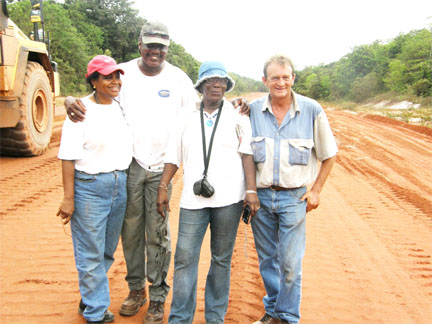(A farewell to potholes)
Infrastructure Development
Romix, a South African company known for research into road construction technology believes it can play a role in improving Guyana’s coastal and interior road networks, including the road link between Guyana and Brazil.
Romix has spent twelve years working with The Council for Scientific and Industrial Reasearch (CSIR) in South Africa creating what Managing Director Pieter Prinsloo describes as “innovative road construction technologies” that seeks to “build long-lasting, quality roads; to reduce the time spent on construction by 90% and to reduce construction costs by at least 40%. “

Prinsloo and Trinidad and Tobago-born Evelyn Lewis-Mwamba, who is the Regional Distributor for Romix products, spent a week in Guyana meeting with government officials including Prime Minister Samuel Hinds and municipal officials and overseeing trials of the Polymex road construction products on the Mabura road and Prinsloo says that the choice of the Mabura road was intended to demonstrate that the technology can be applied “on some of the most challenging surfaces.” He says that the outcome of the Mabura “trials” could persuade Guyana to embrace the Polymer option which could also be an option for the Linden/Lethem road. Following discussions with local officials Romix has secured the services of the South African consulting engineering firm Sizotech to conduct a technical survey of the road project the results of which will be made available to the government. Sizotech has conducted similar studies for Romix in the Cameroon.
Prinsloo says that he is “particularly confident” about the role that the Polymer technology can play in remedying the pothole problem plaguing Guyana’s coastal roads, The process of fixing potholes using Polymer material involves, first the removal of loose material from the potholes then applying a liquid resin to the edges of the fractured area to stabilise and to seal the area to prevent the ingress of water at a later stage. If the pothole is particularly deep the area is restabilised using a mixture that includes ordinary laterite material. That material is compacted into the hole and a cold asphalt mixture is then poured on top of it then compacted into the surface. “After five minutes the road can then be opened to the heaviest traffic,” Prinsloo says.
The labour-intensive nature of the technology is also good for Guyana. Workers can be taught to apply Polymer products during a ten minute demonstration,” Princeloo
The Georgetown City Council has evinced a keen interest in the Polymer technology and plans are in train for Romix to conduct two sets of trials on potholes on urban streets.




